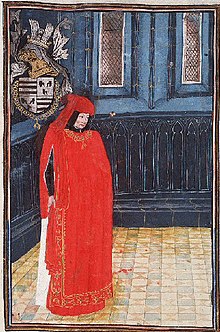Antoine I. de Croy


Antoine I. de Croÿ , called "the great" (French: le Grand) (* around 1402; † after October 21, 1475 ), from the old Picard noble family of the Lords of Croÿ , became Count of Porcéan and was temporarily dominant minister at the Burgundian court.
Life
Antoine was first chamberlain (French: chambellan) to Duke Philip "the good" of Burgundy and an experienced military leader. In the Grand Council of Duke Philip he was one of the three most powerful councilors during his entire reign. For his services, Antoine received rich donations and favors from Duke Philipp, and he was able to significantly increase his initially modest rank of nobility. In 1430 he was one of the first 24 members of the Order of the Golden Fleece .
Due to their geographical origin, the Croÿ often stood between France and Burgundy. In order to promote French interests in Burgundy, Antoine received large sums of money from the French kings, such as 10,000 saluts from King Charles VII .
In 1442 he was governor of the Netherlands in the absence of the duke . In addition, he was appointed governor of Namur , Luxembourg (since 1443), Boulogne and captain of Saint-Omer . From 1452 he held the title of capitaine général (bearer of the ducal banner).
Since 1456 the overpowering position of the "family clan" of the Croÿ led to tensions at the Burgundian court, from which the Croÿ initially emerged victorious, while the Duchess Isabella , the Hereditary Prince Charles the Bold and their supporters were ousted. From 1454 to 1464 Antoine ruled the entire Burgundian state and filled vacant offices with his favorites. Under the influence of the Croÿ, Duke Philip agreed in 1463 to sell back the summer cities, which had been in Burgundian possession since the Treaty of Arras (1435) , to King Louis XI. of France too.
According to rumors, Antoine is said to have planned an assassination attempt on Hereditary Prince Karl. After a reconciliation between Duke Philip and his son Karl had taken place in 1464 and he had been governor-general from 1465, Karl announced his indictment on March 12, 1465 against the Croÿ, who fled the Burgundian territories ( Ligue du Bien public ). Antoine was not rehabilitated until 1473 during the feast of the Order of the Golden Fleece.
Possessions
According to his will of 1450, he had eleven dominions, including the Picardy county of Porcéan, with a total value of about 60,000 francs , and he could muster 900 knights.
In 1433 he acquired the lordship of Le Roeulx (owned by the family to this day) and in 1436 the Château de Montcornet (owned until 1613). Through his second wife (from 1432), Marguerite von Lothringen-Vaudémont, the rule of Aarschot came into the family ( inherited in 1612 through Anne de Croÿ and her husband Karl von Ligne-Arenberg to the Arenberg family). After the execution of Gilles II. De Mortagne al high traitor, Duke Philip handed over his possessions to Antoine in 1433, including the Château de Solre-sur-Sambre and the Château de Potelle, who, however, sold them back to the siblings of the quartered. In 1438 he acquired the county of Porcéan with the castle in Château-Porcien (owned by the family until 1608) and in 1453 Beaumont , which he fortified (destroyed in 1655/91).
Aarschot , Belgium (around 1570)
Château-Porcien , Ardennes
family
Antoine's parents were Jean I. de Croÿ from the Renty family († 1415 at the Battle of Azincourt ) and Marie de Craon . His younger brother was Jean II. De Croÿ , also the holder of influential offices at the Burgundian court. He married
- 1410 Marie (also Jeanne) de Roubaix (1390–1430), daughter of Johann V von Roubaix and Agnès de Lannoy, sister of Pierre von Roubaix .
- 1432 Marguerite de Lorraine-Vaudémont († after 1477), Dame d'Aarschot, daughter of Antoine of Lorraine, Count of Vaudémont († 1458) from the house of Châtenois and Marie d'Harcourt. Through them, the rule of Aarschot came into Antoine's possession.
He had the following children:
- Johanna (around 1435–1504), married March 20, 1454 Ludwig I of Pfalz-Zweibrücken (1424–1489).
- Philippe I. de Croÿ, Comte de Porcéan (1435–1511), his successor, founded the Aarschot line
- Jean III (1436–1505), founded the line to Le Roeulx
- Marie (1440-1489)
- Jacqueline (1445-1486)
- Isabeau (1450-1523)
- Jeanne († 1512), Abbess of the Couvent des Cordelières (Paris)
bibliography
- Karl Theodor Wenzelburger: Croy, Antonie v . In: Allgemeine Deutsche Biographie (ADB). Volume 4, Duncker & Humblot, Leipzig 1876, p. 617.
- Richard Vaughan: Philip the Good. The apogee of Burgundy. London Longmans, London 1970, ISBN 0-582-50262-4 .
- Wim Blockmans: Croy - I. Antoine de Croy . In: Lexicon of the Middle Ages (LexMA). Volume 3, Artemis & Winkler, Munich / Zurich 1986, ISBN 3-7608-8903-4 , Sp. 358 f.
- Wilhelm Karl Prince of Isenburg (welcomed), Frank Baron Freytag von Loringhoven: European family tables. Family tables on the history of the European states. Department 6: Between the Meuse and the Rhine. Part 1 = NF Volume 18 (of the complete work). Stargardt, Marburg 1998, ISBN 3-465-02757-4 , plate 107ff., (On the genealogy of the Croy).
- Raphaël DeSmedt (ed.): Les chevaliers de l'ordre de la Toison d'or au XVe siècle. Notices bio-bibliographiques (= Kiel work pieces. Series D: Contributions to the European history of the late Middle Ages. 3) 2. édition entièrement revue et enrichie. Verlag Peter Lang, Frankfurt am Main 2000, ISBN 3-631-36017-7 , pp. 34-38, no. 15.
Web links
| personal data | |
|---|---|
| SURNAME | Croÿ, Antoine I. de |
| ALTERNATIVE NAMES | Anton of Croy |
| BRIEF DESCRIPTION | Influential member of the Burgundian court |
| DATE OF BIRTH | around 1402 |
| DATE OF DEATH | after October 21, 1475 |




